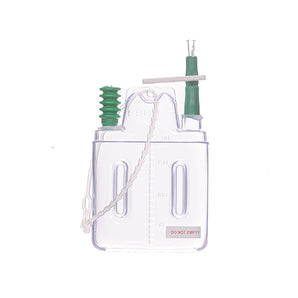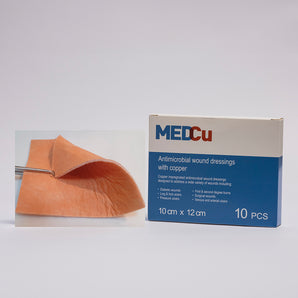- Hydrocolloid dressings turn white due to a chemical reaction with wound exudate, signalling active gel formation that promotes healing.
- The white appearance is not a sign of infection or product failure but indicates the dressing's effectiveness in maintaining a moist environment.
- These dressings are designed to provide moisture management, bacterial protection, reduced pain, and extended wear time.
- Factors like wound type, exudate levels, and proper application influence the degree of colour change and overall dressing performance.
- Hydrocolloid dressings are suitable for low to moderate exudate wounds, including pressure ulcers and post-surgical sites, offering versatile and reliable wound care solutions.
- Proper usage, including regular monitoring and correct application, ensures optimal healing outcomes.
Hydrocolloid dressings are a cornerstone in modern wound care, valued for their ability to create a moist environment that supports healing. If you've ever used one, you might have noticed it turning white over time. This change often raises questions, but it's a normal and essential part of the dressing's function.
When hydrocolloid interacts with wound exudate, it forms a cohesive gel that protects the wound and manages moisture effectively. The white appearance is a visible sign of this process, indicating the dressing is working to maintain optimal conditions for healing. Understanding why this happens can help us appreciate the science behind these innovative dressings and their role in wound management.
What Is Hydrocolloid?
Hydrocolloid refers to a type of advanced wound dressing designed to create an optimal environment for healing. These dressings consist of a flexible, sterile material that reacts with exudate from the wound. Upon contact, hydrocolloid forms a gel-like substance that helps maintain a moist microenvironment essential for wound recovery.
The material is impermeable to water and bacteria, safeguarding wounds against external contaminants. This property ensures better exudate management while facilitating the natural healing process. Hydrocolloid dressings are especially effective for wounds with low to moderate exudate, such as pressure ulcers and post-surgical sites.
Our hydrocolloid wound dressing promotes effective cleaning and supports healing by maintaining the moisture level needed at the wound site. For healthcare providers across Africa, solutions like this ensure consistent and reliable outcomes in the realm of advanced wound care.
The Science Behind Hydrocolloid Turning White
Hydrocolloid wound dressings exhibit a fascinating reaction when exposed to moisture, which results in them turning white. This visible change signals active interaction with wound exudate, which is crucial for effective healing and protection.
Composition Of Hydrocolloid
Hydrocolloids consist of hydroactive particles like carboxymethylcellulose embedded in a flexible, adhesive base. These particles form the core structure that enables the dressing to react to moisture. The adhesive, conformable design not only ensures a secure fit but also creates a protective barrier against bacteria and water. This dual action supports wound protection and healing.
Our focus on creating high-performance hydrocolloid wound dressings prioritises sterility and durability, making them suitable for a range of wound types, including pressure ulcers. By tailoring this composition, we ensure effective exudate management and adaptability to low to moderate moisture levels.
Interaction With Moisture
When hydrocolloid dressings come into contact with wound exudate, their hydroactive particles absorb the moisture. This absorption initiates a chemical reaction, transforming the particles into a gel-like substance. The white appearance is an indicator of this gel formation, reflecting the dressings' effort to maintain a moist environment.
This gel plays an essential role in wound care. It preserves an optimal healing temperature, absorbs excess exudate, and prevents maceration of surrounding skin. By fostering these conditions, our dressings align with healthcare goals to improve healing outcomes across Africa.
Hydrocolloid wound dressing solutions, like those we offer, demonstrate how advanced material science contributes significantly to improving medical care accessibility and efficiency.
Key Factors That Affect Colour Change
Hydrocolloid wound dressings turn white due to specific factors linked to their interaction with the wound environment. Understanding these factors helps clarify the dressing's functionality and its role in efficient wound care.
Absorption Of Fluids
Hydrocolloid dressings absorb wound exudate, forming a gel that promotes healing. The absorbed moisture reacts with hydroactive particles like carboxymethylcellulose embedded within the dressing. This reaction alters its appearance, causing it to turn white. The gel safeguards the wound bed, retaining moisture and protecting against bacteria and contamination. If the dressing absorbs more exudate, typically in wounds with moderate secretion, the colour change may become more pronounced.
Skin Conditions And Wound Types
The type and condition of the wound significantly influence the extent of the colour change. For instance, pressure ulcers and venous leg ulcers usually produce moderate exudate that triggers the whitening process. Similarly, burn wounds (first and second degree) and post-surgical sites may involve varying exudate levels, directly affecting the hydrocolloid's colour transformation. Dry wounds or abrasions absorb minimal moisture, making the change less noticeable.
These factors, combined with the advanced material composition of hydrocolloid wound dressing, enhance their suitability for diverse wound management applications.
Common Myths And Misconceptions
Transparent, gel-forming hydrocolloid wound dressing often lead to misunderstandings regarding their transformation during use. Let's address some common misconceptions to clarify their purpose and function.
Is It A Sign Of Infection?
A white hydrocolloid dressing doesn't imply infection. Instead, this change occurs due to the absorption of wound exudate. The gel formation, which causes the whitening effect, represents active interaction with moisture, promoting a moist environment for healing. According to evidence available in wound care research, the white appearance confirms the product's effectiveness, not the presence of harmful bacteria.
However, specific signs like odour, redness around the wound, swelling, or increased pain may indicate an infection. In such cases, consulting a healthcare provider is recommended rather than misinterpreting the dressing's whitening phenomenon.
Does It Indicate Product Failure?
The whitening effect doesn't signify product failure. Hydrocolloid wound dressing, including high-quality solutions offered by Dynamed Pharmaceuticals, are engineered to interact with exudate, forming a protective gel. This transformation is part of their design and purpose, ensuring wounds stay moist and shielded from external contaminants.
Improper application, such as misalignment or using the dressing on dry wounds, might lead to suboptimal performance, but not product failure. Ensuring the proper selection of dressing size and type for the wound condition enhances outcomes in wound care.
Benefits Of Using Hydrocolloid Dressings
Hydrocolloid wound dressings offer a range of advantages that support effective wound care. They create an optimal healing environment by maintaining a moist setting, which promotes cell regeneration and minimises scab formation. This ensures faster and more comfortable recovery.
-
Effective Moisture Management
Hydrocolloid dressings interact with wound exudate to form a cohesive gel. This gel preserves hydration, enabling wounds to heal without drying out or becoming overly macerated.
-
Protection From Bacteria
These dressings serve as a barrier against harmful bacteria and contaminants. With their impermeable surface, they lower the risk of infections while shielding wounds from external exposures.
-
Minimised Pain Levels
Hydrocolloid dressings cushion the wound, reducing friction and irritation. Patients benefit from decreased discomfort during healing and fewer dressing changes.
-
Extended Wear Time
Their long-lasting design can stay in place for multiple days, depending on the wound type and exudate levels. This results in fewer replacements, helping healthcare providers optimise resources.
-
Waterproof Properties
These dressings are water-resistant, allowing patients to bathe or shower without compromising the dressing's integrity or effectiveness.
Our hydrocolloid dressings, including those from medical brands like Dynamed Pharmaceuticals, reflect advanced design tailored for healthcare needs. They're highly versatile, suitable for wounds with low to moderate exudate such as pressure ulcers and post-surgical sites. By ensuring protection, comfort, and reliable healing, hydrocolloid dressings provide essential solutions for providers across Africa.
Tips For Effective Use Of Hydrocolloid
Hydrocolloid wound dressing is a versatile and effective solution for many wound types. To maximise its potential, it's essential to understand proper usage and care.
When To Change The Dressing
Change the dressing typically every 3 to 7 days, depending on exudate levels and manufacturer guidelines. A visibly white or swollen hydrocolloid indicates moisture absorption and may signal the need for replacement. For wounds with low exudate, monitor closely to avoid maceration caused by prolonged gel retention.
If leaks or odours occur, immediate replacement is essential to maintain a sterile wound environment. Adapt frequency based on wound condition and healing progress.
Proper Application Techniques
Prepare the wound by cleaning it with a suitable wound cleanser before applying the dressing. Dry the surrounding skin completely to ensure a secure adhesive bond.
Cut the dressing to size, ensuring it overlaps the wound edge by at least 2cm. Avoid stretching during application, as this can compromise the seal. Press gently from the centre outward to remove air bubbles and secure the dressing.
Use gloves to maintain sterility when handling the dressing. Position it firmly but without excessive force to reduce pressure and skin irritation risks.
Hydrocolloid wound dressing, such as those offered by Dynamed Pharmaceuticals, is ideal for creating a moist environment that promotes healing. Ensure all steps are followed carefully for optimal results.
Conclusion
Hydrocolloid dressings stand out as a remarkable advancement in wound care, offering effective moisture management and protection. Their ability to turn white is a testament to their active role in promoting healing, ensuring wounds are cared for in the best possible way.
By understanding the science behind this transformation and following proper usage guidelines, we can maximise their benefits. For healthcare providers and patients alike, hydrocolloid dressings remain a reliable solution for improved healing outcomes and enhanced comfort.
Visit Dynamed Pharmaceuticals
Phone: 0861 00 00 43
Website: dynamed.co.za
Email (Sales): sales@dynamed.co.za
Email (Info): info@dynamed.co.za
Google Maps: Find us here
Frequently Asked Questions
What are hydrocolloid dressings used for?
Hydrocolloid dressings are advanced wound care products used to treat low to moderate exuding wounds, such as pressure ulcers, minor burns, and surgical wounds. They maintain a moist healing environment, promote cell regeneration, and shield wounds from bacteria, water, and external contaminants.
Why do hydrocolloid dressings turn white over time?
The white appearance results from the dressing’s interaction with wound exudate. This process forms a gel-like substance that helps manage moisture and create an optimal environment for faster healing. The whitening indicates the dressing is effectively performing its function.
Do white hydrocolloid dressings mean there’s an infection?
No, the white colour does not indicate infection. It signifies the dressing’s active absorption of moisture and exudate, which supports wound healing. If infection is suspected, consult a healthcare provider for proper evaluation.
How often should hydrocolloid dressings be changed?
Hydrocolloid dressings should typically be changed every 3 to 7 days or when visibly saturated with exudate. Follow manufacturer guidelines and monitor the wound for signs that the dressing needs replacement.
How do hydrocolloid dressings support healing?
These dressings maintain a moist microenvironment essential for cell regeneration, prevent scab formation, and provide cushioning. Their waterproof and bacteria-repelling properties promote faster, safer, and more comfortable wound healing.
Can hydrocolloid dressings get wet?
Yes, hydrocolloid dressings are waterproof, allowing patients to bathe or shower without compromising the dressing’s integrity. This ensures consistent protection throughout their wear time.
What types of wounds are suitable for hydrocolloid dressings?
Hydrocolloid dressings are ideal for wounds with low to moderate exudate, such as pressure ulcers, leg ulcers, surgical sites, and minor burns. They are not suitable for heavy-exuding, infected, or dry wounds.
How should hydrocolloid dressings be applied?
To apply, clean and dry the wound, cut the dressing to size, and ensure proper sterility during application. Press down gently to seal the edges and create a protective barrier. Follow instructions for best results.
Are hydrocolloid dressings available in Africa?
Yes, hydrocolloid dressings, such as those from brands like Dynamed Pharmaceuticals, are accessible across Africa. These dressings support advanced wound care with reliable and consistent performance.
What are the main benefits of hydrocolloid dressings?
Hydrocolloid dressings offer moisture management, bacterial protection, extended wear time, pain reduction, and faster recovery. Their versatility and waterproof design make them suitable for various wound types and everyday use.






